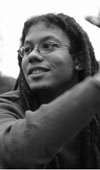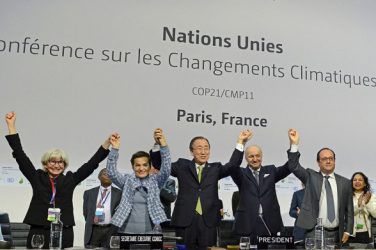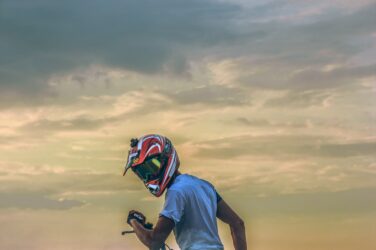Is there such a thing as European identity? If so, is it something you can represent visually? Something you can see with the naked eye? American photojournalist Damaso Reyes tries to catch the European spirit, finding out how our identity has evolved over the years.
Since 2005, Damaso Reyes has been wandering around Europe, from fancy London to post-war Kosovo, through rural Brittany and high-tech Geneva, photographing people and trying to find out what makes us ‘The Europeans’. His book is a work in progress –just like the European identity, and he plans to finish it in a couple of years. The photojournalist shares with E&M what he has noticed after so many years glaring at Europe’s face –it looks beautiful, but there are some wrinkles we have to smooth out too.
Born and raised in Brooklyn, New York, he began his career as a photojournalist 10 years ago. His work has been published in the UN Development Programme, The Associated Press, The Wall Street Journal, Vanity Fair Germany and Der Spiegel, among others.

Born and raised in Brooklyn, New York, he began his career as a photojournalist 10 years ago. His work has been published in the UN Development Programme, The Associated Press, The Wall Street Journal, Vanity Fair Germany and Der Spiegel, among others.
Photo:Damaso Reyes, Licence: www.theeuropeans.net
E&M: Why did you decide to start this project?
In 2002, I was living in Indonesia and had been there for little over a year. I had to decide if I wanted to stay or I wanted to leave. I thought, if I go back to New York I don’t want to just photograph press conferences, I don’t want to fall into the trap that so many of my friends and colleagues fall into.
I needed a plan, I needed an idea. I started to think about the work of photographers I admire. One of these photographers is a Swiss named Robert Frank. In the late 1950’s, Frank produced a book called “The Americans” where he travelled around the United States photographing what he saw. That was in early 2003. The Euro had just been introduced as currency, as a journalist I am always following the news and there was a lot going on in Europe. The European Union was actually becoming a viable political and economic entity, and the thought just popped in my head: Wouldn’t it be interesting if an American travelled to Europe and started to photograph what he saw from his outsider’s perspective the same way as Robert Frank did fifty years previously?
After thinking and thinking about it for months, on April15th 2005 I got on a plane to London and started working on the project. It was scary because the only idea I had was to photograph how Europe was changing. I had no concept about of how would I do that visually i didn’t know what pictures I would take…
E&M: No plans? No content-framing? nothing?
No. I just said: I’m gonna start in London. Then I did have the plan to go to Kosovo, and then to the Netherlands. But what I would photograph, what people I would encounter -I had no clue.
E&M: Did you find what you were looking for?
I found a lot of things I wasn’t looking for, and for me that’s the moral of the story. This project has challenged me to be open to things which I don’t know about, people I’ve never met, I just trusted that I would find what I’m looking for in a very broad sense. And it’s been true. This project has taught me to put away my preconceptions and try to be open to what I discover.
Did you have preconceptions about Europe?
I had a lot of preconceptions. I think it’s impossible to go trough life without any preconceptions. The challenge is: when you discover things that challenge your preconceptions, do you stay with them or do you change them?
A concrete example would be probably France. As an American I certainly have a preconceived idea of France. Everyone tells me: “Oh, the French are so unfriendly, so rude”. All the time I spent in France has been amazing. I met the most open, wonderful people who shared their homes and their stories with me. When you haven’t been to a place, all you have are clichés. In France people do say “voilá”. You go to a pastry shop and you order a croissant and they bring it to you and say “voilá”. It’s true, but there is a lot more to France than that. Through my work I want to challenge other people’s preconceptions about the way they see their neighbors, the way they see themselves, the way they see foreigners.
There is something that is European. I don’t know how to define that, I can’t point my finger at it, but there is an attitude, a way to approach life, which does exist and doest manifest itself on a visual way.
E&M: What is the process of your work?
It varies. In that particular case, I decided to spend 6-7 weeks in London and see what I found. Part of that is doing research and saying I’m interested in photographing this place, this person or this area, and some of it is walking down the street and seeing what you encounter. Both are very valid methodologies. For instance in Geneva I photographed CERN, the particle physics laboratory. That took research, a lot of negotiation, organization and logistics.
There are times when you are walking down the street, like in London, and you encounter a person who you want to spend a week photographing. If you hadn’t been walking down that street you’d haven’t met that particular person. I try to combine the two. One of the things I try to do is to talk to people who live in the place where I am photographing and ask them: “If you were photographing the theme I am photographing what would you take a picture of?” And you get a lot of interesting answers. Sometimes there are things that you think are boring, and sometimes you get the insiders’ perspectives.
There was a real fear that I get to a place and I wouldn’t be able to get beyond of the cliché. But it’s a healthy fear to have, because you don’t want to be too dependent on what you think you know about a place. It’s very easy, especially as a photographer, to fall onto a visual cliché. The kind of work I do tries to get below the surface.
E&M: What have you found under this surface that surprised you?
I have found that clichés are valid to a certain extent. Italian people do say “Mamma mia”. French people do say “voilá”. There are these very superficial things which are true. But what I discovered -and maybe this is part of my perspective as an American, but I don’t think so a 100%- is that in Europe people are more similar than they are different.
I think that in people’s aspirations, their desires, the way they relate to each other… There is a similarity that exists throughout. If you look at my pictures you will see differences but I think you also see a visual narrative. Europeans are very different from each other. But there is something that is European. I don’t know how to define that, I can’t point my finger at it, but there is an attitude, a way to approach life, which does exist and doest manifest itself on a visual way.
E&M: And what is this visual way?
You have to look at the pictures. It’s like talking about music. One example for me is that I spent about three months living in a small town in Slovaquia on the Hungarian border. It was a town of 10.000 people if not smaller. There is a local high school and I got invited to photograph at their Spring dance. I was taking pictures of young men dancing with young women and all the things that we do as teenagers, and then when I saw the pictures this reinforced the idea that this could be in France, in Italy, in Germany, in England…
E&M: But could it be in the United States?
It could be, but there’s something that is sort of uniquely European. There’s a growing European consciousness or identity. The Schengen generation –which is the people under thirty- is much more interested in having a European identity than a national identity. That is to say they are German, they are French, they are Dutch, but they travel extensively throughout Europe. In some cases because of programs like Erasmus.
E&M: I’m from Barcelona and did my Erasmus in Berlin…
There you go! [laughs] The question I love to post to people is: “If you are a German who studied in Italy and then got a job in France and then you met and marry someone from Spain and have children, what are your children? Are they Spanish? are they German? Are they French because you live in France?” This is the question Europeans are going to be struggling with and are going to have to answer over the next twenty, thirty, forty years: what makes me who I am?
When it comes to the question of immigration, it’s even more important because especially in Western Europe this idea that nationality is tied with genealogy is something which is going to have to change, whether you like it or not. Demographics is what matters. The birth rate in Spain, Italy, Germany, France is all down. Who are the only people who are having children? Immigrants. So all of these countries are going to have to import labor to maintain their social welfare states -it’s not a bad thing, I’m a big fan of European welfare states, I think America has a lot to learn from that – but you can’t invite anybody to your country and let them have children, grandchildren and great-grandchildren and then say to them: “You’re not German”, “You’re not French”, “You’re not Italian”, just because the way they look. Just because your great- great- great- great-grandfather wasn’t born in Bolonia or Marseille. That’s over.
E&M: And how is Europe doing in integrating immigrants?
Europeans are still reconciling that idea and we see it in the ban against the headscarf and in all these reactionary laws which are being passed. As an American I feel that Europe can learn from us in that sense. It wasn’t until in the middle part of the last century -and it was a very violent and difficult social upheaval in the US- when we decided: look, we are going to give all of our citizens full participation rights. And we are still struggling with this, even though we have a black president. Europe has begun to touch this issue and it needs to. The reason why a third generation French-Algerian woman wears headscarf or wears the full veil is because more often than not she feels that no matter what she does, white French citizens will never see her as French as they are. So she says to herself: “They don’t see me as French, then I wear the headscarf, because at least then I have an identity”.
The French say “liberté, égalité, fraternité”, you know, unless this is in practice… How many parlamentarians of color do they have? How many TV presenters of color, on the cover of French Vogue, how many black or arabic models do they have? These are the real questions which Europeans in general have to answer. This is part of what I try to show through my work, that these other people are also European whether they are asylum seekers or third generation or however you want to define it. These people also are part of the story of Europe.
That’s what I try to show through my work, that these other people are also European whether they are asylum seekers or third generation or however you want to define it. These people also are part of the story of Europe.
E&M: What shocked you the most in a negative way?
Racism and classism. I would say classism more in the UK, and racism in places like Germany or Austria. People see me in a place like Austria and say: “Oh you’re an asylum seeker”. People just look at you and they’re like: “Why are you here? You don’t belong here.” And when they talk with you they realize and say: “Oh, you’re an American, you’re educated, you’re shocking”. Being judged just because of the way you look or who they think you are. That was surprising. I didn’t encounter that in all Europe. I think in Spain and France it’s a lot more relaxed, but in places like Germany, the Netherlands, Austria, Switzerland to a lesser degree, it’s very ‘in your face’ and that was something I didn’t expect.
brittanydamasosmall2

E&M: What does the changing face of Europe look like?
It doesn’t look like you would expect, that’s the simple answer. I think it’s unexpected. It’s something different. One of my favourite pictures I took in France, in Brittany, is a picture of a tourist postcard rack with all these postcards. There are postcards of the Côte Sauvage, the Monolits, of women in these traditional dresses… But in one postcard, you have to look to see it, there is a little bit of a mystery: there is this little black girl, and she’s wearing a traditional dress and it just says “Bretagne”. It’s one out of the twenty or thirty postcards you see in the picture, but that is part of the way Europe is changing. It’s Brittany too, it’s France too, and is being acknowledged in a mass media-public sort of way.















